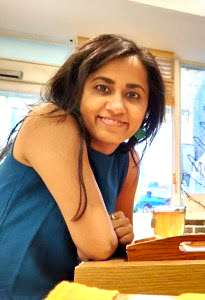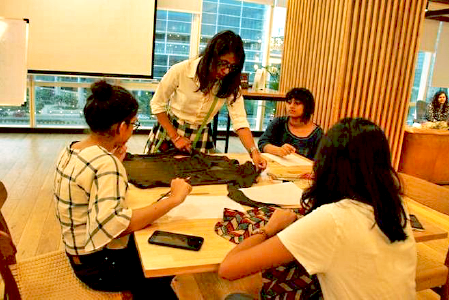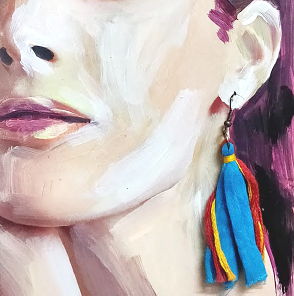Real Life Stories: People Trafficking in India (Katran)
The latest in our series of partner interviews is with Swati Soharia. She is the Founder and CEO of Katran. Swati graduated from the National Institute of Fashion Technology (NIFT), New Delhi in 2011. Then in 2017, Swati launched Katran, the label, which is a natural outcome of her love for fashion and passion for sustainable living. Katran trains and employs women from marginalized communities to upcycle waste fabric into handcrafted, one-of-a-kind accessories. They are an all-women team and follow a strict zero-waste policy.
To promote responsible design practices, Swati continues to take guest lectures at top tier fashion institutions. She also collaborates with businesses and society to promote conscious consumerism.
Liluye’s staff writer, Emma Lees, interviewed Swati to find out more about their work.
To watch Swati’s interview, please watch below:
This is the Liluye interview of Swati:
Swati is based in New Delhi, India and she has been passionate about working with sustainable fashion, upcycling and working with marginalized communities in India. Through their work they try to improve the economic and living conditions of those in the communities that they serve whilst recycling and reusing, particularly textile waste and selling these to people across India, and the world. So far, correct me if I’m wrong, you’ve upcycled and recycled four tons of fabric waste in just three years, which is absolutely phenomenal to hear about.
My name is Emma Lees, I’m the staff writer Volunteer from Liluye.
Thank you so much for inviting me, Emma, it’s lovely to be a part of this project.
Why did you first get started in this work?
Honestly Emma, it actually started with my little hobby that I started when I was a little child. I used to play with scraps, paper discards and textile waste. This material used to be my hero product. That’s how I used to create craft. So that kind of lingered on until I became a professional. When I was studying fashion design, I got to see how the fashion industry is kind of unknowingly, or knowingly, leading to a lot of waste. There are tons of fabric which is discarded, production-based fabric which goes into a landfill every single year, and which is basically expanding the size of the landfills. Most of the fabrics that are popular these days are synthetic fabrics, polyesters and the like, which are non-biodegradable and contaminate the soil and water. So, it became something of a mission for me that I wanted to do something about it, and not just say things. I wanted to bring about some change, and in the process I realised that a lot of women are not given importance. Almost all women in the low-income communities know how to stitch and sew, but the professional tailors are mostly men. So it became something of a challenge because it is like an unsaid thing which kind of floats around in the ecosystem… that women are not very good tailors. I took this up as a challenge. That I’ll make sure that I train those women, make them good [tailors] and they can become the workforce for me.
This is an overview, but the triggering effect was a challenge I gave myself, for a year in 2016/17, which was that I wouldn’t shop for a year. I didn’t buy any clothes whatsoever for at least a year. Then there was no looking back. During that time, I wanted to wear something new because everybody’s tempted to wear something interesting once in a while. Then I upcycled my old clothes and my family members’ clothes. They became iconic pieces in my wardrobe, and that got a lot of eyeballs [on my creations]. It was actually the start of the business!
After some time we started looking at factory discards; the fabric that was unused and it became our raw material that we could then construct something new with. We could then bring our trained tailors on board that we were training from these communities and expand from there.
How did you find those women and how did the transition go from doing this alone to a bigger team?
That is a good question as it was a very big hiccup in my journey. I decided to look at women from under-served communities and people in the lower-economic areas. It struck me that “why shouldn’t I look at NGOs?” They are already training women in basic tailoring skills. These women are finishing college and they want work. I could contact those NGOs and they would connect me with the woman directly. So, that is actually what happened and I became part of a lot of training projects with different NGOs.
What kind of women and communities have you been working with? With Liluye we’re working predominantly with those who are trafficking survivors or those at risk in marginalised communities. Are those the types of women that you’re working with?
Yes, that’s right. So firstly, there are trafficked women who are looking for other forms of work. There are some women who are actually still working and living in the brothels and this tailoring is their side work. Eventually they are wanting to kind of switch to this kind of work completely. It is much more respectable (you know sewing work) that they can do it in their own homes. Secondly, there are women in the slums with very low or no income who are also working with us. Again, the mobilisation happens through the NGOs and we provide training to them.
Obviously the partnerships with the NGOs are very important because there are a lot of things which happen in day-to-day life which can make things a challenge. For example, a woman’s health has to be taken care of, including their emotional health and well-being, or if they have some financial issue, then there has to be somebody that they can discuss it with. There are a lot of potential issues. On top of that, there are also a lot of cases of domestic violence, so somebody separate to the training, a support worker, has to be there to help them out with these issues. It is not just any group of people working with you. They have stories. They have all this baggage with them that they need support to be fixed.
Do you think that the work that you’re providing is helping people to transition out of trafficking, and providing an income, because effectively that’s why they’re in the situation in the first place through poverty or a lack of options? Do you think that this is how trafficking can be eradicated?
I think so, yes. But, if we want to work towards zero trafficking, we need to provide some source of livelihood for these people. I was speaking to one of these girls who’s still working in the brothels. She was born and brought up in the brothel, because her mother was a sex worker. It is very normal for her to do this work, because she hasn’t seen the other side. I think that if another side can be introduced and shown to them that there is another way of living, I think there’s nothing like it. I mean that’s certainly the little part that we can play. They also want to understand how they can live beyond their situation. Right now they have a house, in a brothel, for example… a home to live in. Of course there are other kinds of nuances to it, but then if they switch to another kind of work, they won’t have a home. Then they’ll have to find shelter for themselves.
What’s your primary goal at Katran right now?
It’s two things:
• One is eradicating waste and diverting it from going into landfill. I had to specialise. I was looking at a lot of different kinds of waste, such as paper, cardboard, MDF (traditionally made of wood fibers that have been broken down into residuals, mixed with wax and resins and heat pressed into dense, durable sheets) and wood. I decided it has to be fabric first because I like to focus in depth on one material first, and also because I studied it.
• Second is women’s empowerment, because it’s a patriarchal society and women have to take care of the family and all of that. You know the age-old story that’s still prevalent in the rural sector of the country. I’m sure it’s prevalent all over the world, somewhere in pockets.
You’ve achieved a lot in a relatively short period of time, but what would you say is your most memorable achievement?
I would say my exhibitions. All my exhibitions have been really memorable because it’s carefully crafted work by all my women. People come and they have a value for what you see, so that’s an achievement. Of course another landmark was when we had a website where we could sell the products (scarves, bags, sarees, homewares, jewellery). The women got super excited, especially whenever the visitors or clients came. You see the joy on their faces. It’s something which leaves a mark on you because you’re doing something for them. Then, they realise it, and they’re directly benefiting from it. So it’s fun.
That’s amazing, and I can imagine there must be so much pride for you and for them that you’re not just creating. You’re recycling something, and you’re also creating a piece of art. Something that’s unique and the level of pride is that much greater. Plus you know you’re helping yourself, the community, and the world. That’s phenomenal, and to be able to do that on so many levels. I’m getting goosebumps even as I say that.
To find out more about Katran, your online upcycling workshops, or buying any of your products, where are the best places to find you?
Visit Katran on the web: https://katranstudio.com/
Visit the Katran shop on the web: https://katranstudio.com/shop/
Visit Katran on Instagram: https://www.instagram.com/swati.soharia.upcycling
Thank you so much for your time, Swati. We really appreciate it. It has been fascinating to hear so much about the exciting work that you’re doing and we look forward to working more closely together and hearing about everything going from strength to strength.
Thank you very much.
To learn more about upcycling and Swati’s work in India with Katran, read this article:
Is trashion the future? (livemint.com)
For more information about Liluye or to inquire about becoming a partner, please visit www.liluye.org/contact. Or, if you are interested in donating to Liluye, please visit: www.liluye.org/donate.
Swati was interviewed by Liluye Staff Writer, Emma Lees, who also writes on her blog, InnerExpat.





